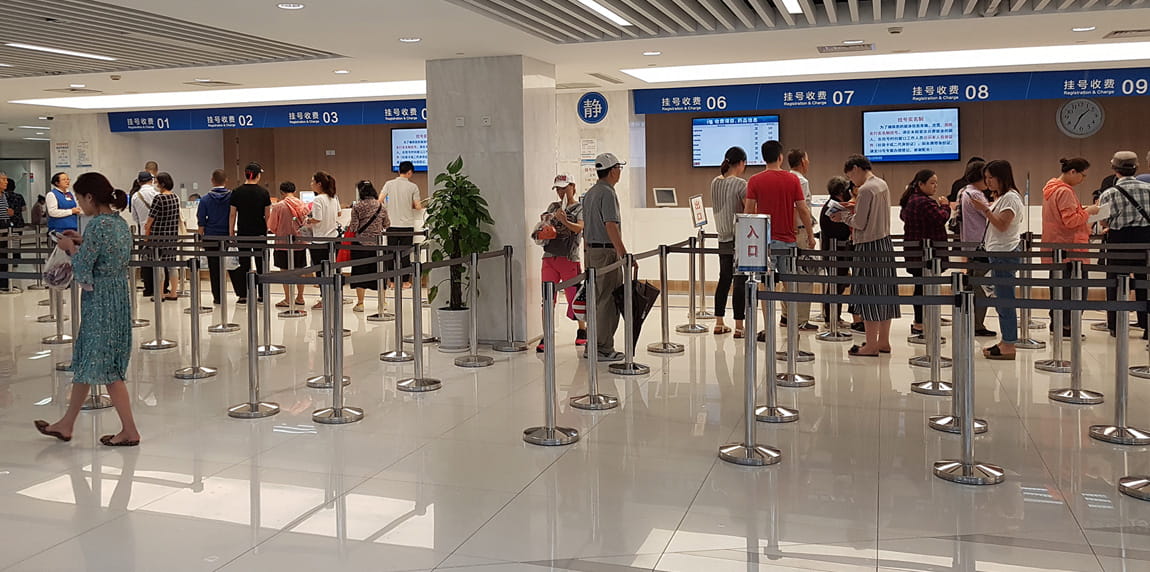Select your investor profile:
This content is only for the selected type of investor.
Individual investors?
Trip notes: opportunities and challenges in Chinese healthcare
Anna Mulholland goes on a fact-finding mission to understand the investment opportunities in the Chinese and Korean healthcare industries
A glimpse of traditional Chinese medicine (TCM)
During a recent tour of a modern Beijing hospital, I asked to see their traditional Chinese medicine department. Like many Westerners I’m both curious and sceptical about these exotic remedies.
Jokingly, I asked whether they might have a cure for jetlag. But they took me seriously and gave me a consultation on the spot and then two of vials of a prescribed mixture. What surprised me most was how my guide, the hospital’s millennial Investor Relations Officer, reacted – astonished disbelief that I might really want to give the cure a try. Nor was he unusual. Chinese millennials generally seem surprised that Westerners might take an interest in their traditional treatments.
I suppose at the roots of that reaction are the concerted efforts China is making in adopting Western-style medicine. The country’s vast and increasingly wealthy, but generally under-provided population is creating a huge market for modern treatments.
I visited some 30 companies involved along the full healthcare chain during my trip to Shanghai, Beijing, Hong Kong and Seoul to find out more.

Chinese healthcare - Opportunities
China wants, and rather desperately needs, a sustainable and self-sufficient healthcare system. The process of attaining this will almost certainly place it as a leader on the global healthcare stage. The urgency to make both of these things happen is palpable within the ‘traditional’ pharma companies and even more so at the Biologics or Biopharma companies.
The pool of patients is immense and their potential clinical needs vast. Pick any disease or condition, and the numbers are staggering. Cancer has been the leading cause of death in China since 2010. Last year four million people were diagnosed with cancer and over two million people died from it. Lung cancer is the most prevalent, followed by stomach and liver cancer, for which China accounts for more than half of cases globally. 100 million people in China have diabetes. 200 million people suffer from high blood pressure. There are over two million new stroke patients each year.
Other, less obvious threats are waiting in the wings too: in a system under pressure from lack of doctors per patient, time to diagnose is short. Over-prescription is common as is drug resistance. One Biotech CFO pointed out that many superbugs will develop in China and the global world we live in means its likely they will spread quickly.
To deliver the necessary medicine and services requires getting over two major hurdles: Accessibility and Affordability. The government’s way of surmounting those hurdles is accelerated new drug approvals and improved cost reimbursements. There is a keen focus on rewarding successful innovation in this way.
Accessibility: Everyone's a winner
On the accessibility challenge, the largest unmet clinical needs are in oncology, auto-immune diseases, and cardiovascular treatments. Other interesting areas include ophthalmology and mental health, where diagnosis rates remain considerably above global averages. Oncology is probably the biggest market opportunity for healthcare companies. Chinese patients have limited access to more advanced cancer treatments – only 29 of 105 targeted therapies approved in the US are currently available in China. Last year, around 60 per cent of cancer treatment in China was via older-generation chemotherapy, compared to 10 per cent in the US.
Competition to take market share in the new and innovative drug space is unsurprisingly fierce but the size of the prize is so large that there should really be no losers.Last year, around 60% of cancer treatment in China was via older-generation chemotherapy, compared with 10% in the US.
Affordability: the pricing pressure is here to stay
China has a single-payer healthcare system – in theory this means the government pays for everything. However, as with the funding of healthcare systems in large economies in the West, the funding needs from government coffers is increasing whilst they themselves are shrinking. As such, patient cost-sharing remains a necessary reality, in some cases for up to 90% of the total treatment cost.
At the heart of price control is the government’s National Reimbursement Drug List. There are 2535 products on the list. When a drug enters the list, its price or level of reimbursement is negotiated via tender. A cut of 50 per cent to the pre-list price is common, especially for branded and innovative drugs. The NRDL has been reviewed every 5 to 7 years in the past but it is likely to be reviewed much more frequently to accommodate the inclusion of more innovative drugs. In fact, at the last list update in 2017, the government put 45 products onto a ‘to be negotiated’ list, half of which were oncology therapies. The drugs which avoid the tender process are exclusive or first to market drugs in therapeutic areas with urgent clinical needs.


Important legal information
This marketing material is issued by Pictet Asset Management (Europe) S.A.. It is neither directed to, nor intended for distribution or use by, any person or entity who is a citizen or resident of, or domiciled or located in, any locality, state, country or jurisdiction where such distribution, publication, availability or use would be contrary to law or regulation. The latest version of the fund‘s prospectus, Pre-Contractual Template (PCT) when applicable, Key Information Document (KID), annual and semi-annual reports must be read before investing. They are available free of charge in English on www.assetmanagement.pictet or in paper copy at Pictet Asset Management (Europe) S.A., 6B, rue du Fort Niedergruenewald, L-2226 Luxembourg, or at the office of the fund local agent, distributor or centralizing agent if any.
The KID is also available in the local language of each country where the compartment is registered. The prospectus, the PCT when applicable, and the annual and semi-annual reports may also be available in other languages, please refer to the website for other available languages. Only the latest version of these documents may be relied upon as the basis for investment decisions.
The summary of investor rights (in English and in the different languages of our website) is available here and at www.assetmanagement.pictet under the heading "Resources", at the bottom of the page.
The list of countries where the fund is registered can be obtained at all times from Pictet Asset Management (Europe) S.A., which may decide to terminate the arrangements made for the marketing of the fund or compartments of the fund in any given country.
The information and data presented in this document are not to be considered as an offer or solicitation to buy, sell or subscribe to any securities or financial instruments or services.
Information, opinions and estimates contained in this document reflect a judgment at the original date of publication and are subject to change without notice. The management company has not taken any steps to ensure that the securities referred to in this document are suitable for any particular investor and this document is not to be relied upon in substitution for the exercise of independent judgment. Tax treatment depends on the individual circumstances of each investor and may be subject to change in the future. Before making any investment decision, investors are recommended to ascertain if this investment is suitable for them in light of their financial knowledge and experience, investment goals and financial situation, or to obtain specific advice from an industry professional.
The value and income of any of the securities or financial instruments mentioned in this document may fall as well as rise and, as a consequence, investors may receive back less than originally invested.
The investment guidelines are internal guidelines which are subject to change at any time and without any notice within the limits of the fund's prospectus. The mentioned financial instruments are provided for illustrative purposes only and shall not be considered as a direct offering, investment recommendation or investment advice. Reference to a specific security is not a recommendation to buy or sell that security. Effective allocations are subject to change and may have changed since the date of the marketing material.
Past performance is not a guarantee or a reliable indicator of future performance. Performance data does not include the commissions and fees charged at the time of subscribing for or redeeming shares.
Any index data referenced herein remains the property of the Data Vendor. Data Vendor Disclaimers are available on assetmanagement.pictet in the “Resources” section of the footer. This document is a marketing communication issued by Pictet Asset Management and is not in scope for any MiFID II/MiFIR requirements specifically related to investment research. This material does not contain sufficient information to support an investment decision and it should not be relied upon by you in evaluating the merits of investing in any products or services offered or distributed by Pictet Asset Management.
Pictet AM has not acquired any rights or license to reproduce the trademarks, logos or images set out in this document except that it holds the rights to use any entity of the Pictet group trademarks. For illustrative purposes only.
